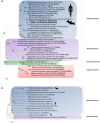Detection of coronavirus in vampire bats (Desmodus rotundus) in southern Brazil
- PMID: 33977671
- PMCID: PMC8242716
- DOI: 10.1111/tbed.14150
Detection of coronavirus in vampire bats (Desmodus rotundus) in southern Brazil
Abstract
The vampire bat (Desmodus rotundus) is a haematophagous animal that feeds exclusively on the blood of domestic mammals. Vampire bat feeding habits enable their contact with mammalian hosts and may enhance zoonotic spillover. Moreover, they may carry several pathogenic organisms, including coronaviruses (CoVs), for which they are important hosts. The human pathogens that cause severe acute respiratory syndrome (SARS-CoV), Middle East respiratory syndrome (MERS-CoV) and possibly coronavirus disease 2019 (SARS-CoV-2) all originated in bats but required bridge hosts to spread into human populations. To monitor the presence of potential zoonotic viruses in bats, the present work evaluated the presence of CoVs in vampire bats from southern Brazil. A total of 101 vampire bats were captured and euthanized between 2017 and 2019 in Rio Grande do Sul state, southern Brazil. The brain, heart, liver, lungs, kidneys and intestines were collected and macerated individually. The samples were pooled and submitted to high-throughput sequencing (HTS) using the Illumina MiSeq platform and subsequently individually screened using a pancoronavirus RT-PCR protocol. We detected CoV-related sequences in HTS, but only two (2/101; 1.98%) animals had CoV detected in the intestines by RT-PCR. Partial sequences of RdRp and spike genes were obtained in the same sample and the RdRp region in the other sample. The sequences were classified as belonging to Alphacoronavirus. The sequences were closely related to alphacoronaviruses detected in vampire bats from Peru. The continuous monitoring of bat CoVs may help to map and predict putative future zoonotic agents with great impacts on human health.
Keywords: Bat; Coronavirus; Desmodus rotundus; PCR; sequencing.
© 2021 Wiley-VCH GmbH.
Conflict of interest statement
The authors declare no competing interest.
Figures


References
-
- Boni, M. F. , Lemey, P. , Jiang, X. , Lam, T. T. Y. , Perry, B. W. , Castoe, T. A. , Rambaut, A. , & Robertson, D. L. (2020). Evolutionary origins of the SARS‐CoV‐2 sarbecovirus lineage responsible for the COVID‐19 pandemic. Nature Microbiology, 5, 1408–1417. 10.1038/s41564-020-0771-4 - DOI - PubMed
-
- Brandão, P. E. , Scheffer, K. , Villarreal, L. Y. , Achkar, S. , Oliveira, R. D. N. , Fahl, W. D. O. , Castilho, J. G. , Kotait, I. , & Richtzenhain, L. J. (2008). A coronavirus detected in the vampire bat Desmodus rotundus. Brazilian Journal of Infectious Diseases, 12, 466–468. 10.1590/S1413-86702008000600003 - DOI - PubMed
MeSH terms
Substances
Grants and funding
LinkOut - more resources
Full Text Sources
Other Literature Sources
Research Materials
Miscellaneous

